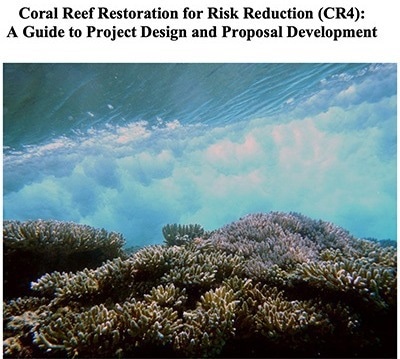The report given by a multi-agency working group aids communities looking for financial support for projects to decrease flood risks by restoring coral reefs for storm hazard mitigation and climate adaptation.
 The new report provides guidance on the development of coral reef restoration proposals for federal hazard mitigation funding. Image Credit: Curt Storlazzi, USGS
The new report provides guidance on the development of coral reef restoration proposals for federal hazard mitigation funding. Image Credit: Curt Storlazzi, USGS
UC Santa Cruz played a foremost role in a multi-agency group functioning for the US Coral Reef Task Force to offer direction on developing coral reef restoration proposals for federal hazard mitigation funding.
UCSC scientists collaborated with the Federal Emergency Management Agency (FEMA), U.S. Geological Survey (USGS), U.S. Army Corps of Engineers (USACE), and National Oceanic and Atmospheric Administration (NOAA) on the project, which was accepted and reported by the Task Force in December.
Austen Stovall, the report’s lead author, worked on the project as a graduate student in the Coastal Science and Policy Program at U.C. Santa Cruz.
We developed this guide to help local project champions to apply for funding from FEMA and USACE to reduce coastal flooding by restoring coral reefs.
Austen Stovall, Study Lead Author, UC Santa Cruz
Research Professor Michael Beck, who has the AXA Chair in Coastal Resilience and guides the Center for Coastal Climate Resilience at U.C. Santa Cruz, observed that billions of dollars in federal funding are available for risk mitigation and failure recovery projects.
Under the Biden administration, FEMA wants to fund nature-based projects. Unfortunately, communities have not had the tools to be successful in winning funds for habitat restoration for coastal protection; we are solving that problem with this report.
Michael Beck, Director, Center for Coastal Climate Resilience, UC Santa Cruz
Coral reef restoration given for risk reduction (CR4) projects is diverse from only ecological coral restoration projects in that CR4 project’s targets to satisfy two different management objectives—environmental conservation and threat mitigation.
Frequently, they will need highly specific placement and planning, elaborate hydrodynamic analyses, and bigger project scales to fulfill both objectives.
FEMA offers billions of dollars in hazard mitigation support to communities annually to decrease or remove long-term disaster risks. For instance, in July 2022, President Biden declared that $2.3 billion would be available in the present fiscal year for pre-disaster hazard mitigation projects via FEMA’s Building Resilient Infrastructure and Communities (BRIC) Program.
As per Stovall, this huge amount of funding available via federal hazard mitigation sources could considerably increase the scale at which coral restoration could be applied, as long as projects also fulfill risk mitigation objectives.
Since this is a comparatively new approach, several stakeholders, such as natural resource managers, community leaders, and government entities, might not understand when and where it can be utilized for flood risk decrease nor how to employ funding for CR4 projects from agencies that offer funds for threat mitigation or disaster recovery.
Beck’s Coastal Resilience Laboratory at UCSC has been involved in a range of projects connected to coral reef restoration. This includes work with the USGS and the Nature Conservancy to progress CR4 efforts in the U.S. Virgin Islands, with financial support from FEMA.
Also, his group is part of a collaborative coral reef restoration project concentrated on safeguarding susceptible coastal regions in Florida and the Caribbean and financial support by the U.S. Defense Advanced Research Projects Agency (DARPA) as part of its worldwide Reefense research program.
Coral reefs are known to be biologically complicated and highly diverse ecosystems that offer a range of main ecosystem services for people. The complete economic value of coral reefs in the United States—depending on their contributions to fisheries, tourism, and coastal protection—has been evaluated at $3.4 billion.
Coral reefs provide coastal safety by decreasing flooding and erosion via wave breaking and friction. On average, coral reefs tend to disperse 97% of wave energy prior to it reaching coastlines.
Stovall feels that coral reefs safeguard flooding over 18,000 people, $825 million in coastal infrastructure, and $700 million in economic activity per year in the United States.
Beck’s team has been at the cutting edge of making the case for the value of nature-based solutions in coastal safety and adaptation to climate change. Beck and his team have collaborated with federal agencies and the insurance industry on a range of projects to illustrate the value of coral reefs, coastal wetlands, and mangroves for coastal defense.
Also, Beck observed that the methods described in the CR4 guidance document could be utilized to aid several other nature-based projects and suggestions beyond reef restoration for federal hazard mitigation funding.
Journal Reference:
Austen, S., et al. (2022) Coral Reef Restoration for Risk Reduction (CR4): A Guide to Project Design and Proposal Development. doi.org/10.5281/zenodo.7268962.